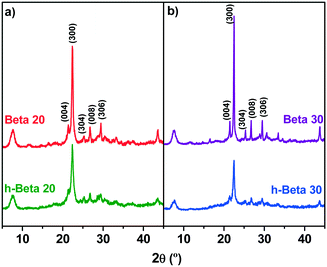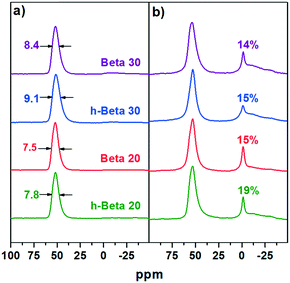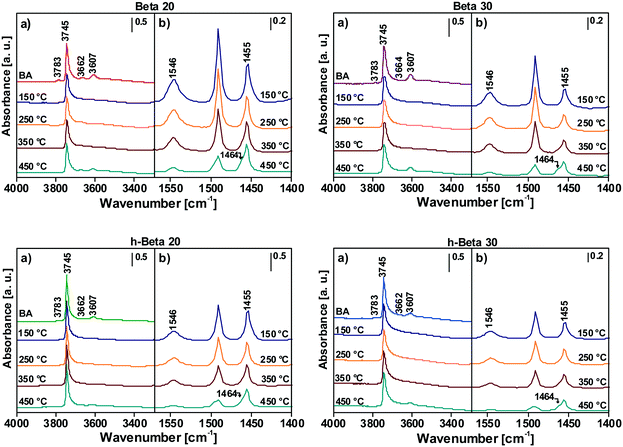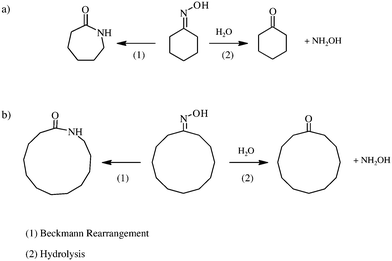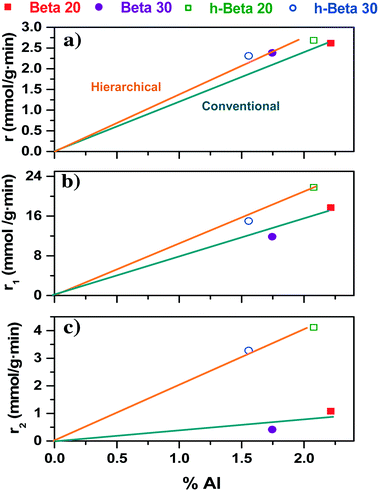Effect of hierarchical porosity in Beta zeolites on the Beckmann rearrangement of oximes
M.
Linares
a,
C.
Vargas
a,
A.
García
a,
C.
Ochoa-Hernández
c,
J.
Čejka
c,
R. A.
García-Muñoz
a and
D. P.
Serrano
*ab
aEnvironmental and Chemical Engineering Group, ESCET, Rey Juan Carlos University, c/Tulipán s/n, 28933, Móstoles, Spain. E-mail: david.serrano@urjc.es; Tel: +34 916647450
bIMDEA Energy Institute, Avda Ramón de la Sagra, 3, 28935, Móstoles, Spain
cJ. Heyrovský Institute of Physical Chemistry, Academy of Sciences of the Czech Republic, v.v.i., Dolejškova 3, 182 23, Prague 8, Czech Republic
First published on 9th November 2016
Abstract
Hierarchical Beta zeolites with different Si/Al molar ratios, synthesized by crystallization of silanized protozeolitic units, were investigated in the liquid-phase Beckmann rearrangement of cyclohexanone and cyclododecanone oximes. The hierarchical Beta samples contain mesopores with sizes in the range 2.0–6.0 nm, as well as the typical zeolite micropores, showing a great contribution of the mesopore/external surface area (300–328 m2 g−1) to the BET surface area (706–763 m2 g−1) and increased Lewis acidity compared to conventional Beta zeolites. Diffusional and steric limitations were found to strongly influence the oxime Beckmann rearrangement as enhanced conversions were obtained with the hierarchical Beta zeolites. The largest differences between conventional and hierarchical Beta zeolites were denoted with the bulkier oxime, i.e. in the rearrangement of cyclododecanone oxime. In this case, two stages are clearly observed in the evolution of the oxime conversion along the reaction time, with a plateau being reached at long reaction times due to deactivation by product inhibition. Hierarchical Beta zeolites exhibited superior performance in both stages compared to reference samples. These results indicate that the use of hierarchical Beta zeolites for oxime Beckmann rearrangement leads to significant improvements in the catalytic behavior compared to conventional Beta samples due to a number of factors: faster intracrystalline diffusion, availability of non-sterically hindered mesopore/surface area and lower deactivation through product inhibition.
1. Introduction
Beta zeolite is a well-known material having 12-ring intersected channels, with pore diameters about 6.6 Å. This size is within the range of many molecules of industrial interest, explaining why zeolite Beta has shown relevant properties in a variety of applications as a catalyst or adsorbent.1–3 In particular, zeolite Beta exhibits remarkable catalytic performance in reactions involving relatively bulky compounds as those involved in fine chemistry reactions.4–6 Nevertheless, when the molecular size of the latter approaches or is even larger than the micropores of Beta zeolite, important diffusional and/or steric hindrances may appear.High interest has emerged in the past years for the development of hierarchical zeolites, featuring mesoporosity and therefore enhanced accessibility.7–12 When used as catalysts, hierarchical zeolites present usually lower steric and diffusional limitations. A wide variety of methods have been reported for the synthesis of hierarchical zeolites based on different bottom–up or top–down strategies, such as surfactant templating, desilication, synthesis within carbon matrixes and use of organosilanes.13–15
The method employed in the present work for the preparation of hierarchical Beta zeolite is based on the generation of mesopores by a bottom–up approach.16 In particular, protozeolitic nanounits are first generated, being subsequently functionalized with an organosilane reagent. The presence of these organic moieties over the outer part of the nanounits hinders partially their aggregation during the subsequent hydrothermal treatment leading to the formation of mesopores upon calcination. This method has been successfully applied to the synthesis of TS-1, ZSM-5, ZSM-11, Beta and mordenite zeolites with hierarchical porosity.12,17–19 These materials have shown improved catalytic activity compared to conventional zeolite samples in a variety of reactions, such as polyolefin cracking, olefin epoxidation, glycerol etherification, acylation of aromatic compounds and epoxide rearrangement.20–23
Previous works reported that the introduction of mesopores in zeolites may affect their acidic properties since the nature and strength of the acid sites located over the mesopore surface can be different from the sites confined in the zeolite micropores.24 This is also a relevant factor that usually affects significantly the catalytic behaviour, hence it must be carefully taken into account when analysing and correlating the results of catalytic tests obtained with hierarchical zeolites.
Beckmann rearrangement is a classical route employed in organic chemistry to transform ketoximes into amides.25 The most important industrial example is the conversion of cyclohexanone and cyclododecanone oximes into their corresponding lactams (ε-caprolactam and ω-laurolactam), which are the precursors for the fabrication of Nylon 6 and 12, respectively.26 Vapour-phase Beckmann rearrangement reactions are usually carried out over solid acid catalysts at reaction temperatures above 250 °C. A rapid catalyst deactivation is often encountered due to coke formation and irreversible adsorption of reaction products.27,28 In contrast, liquid-phase systems appear to be more promising since the use of lower reaction temperatures and the presence of a solvent may attenuate the catalyst deactivation.29
In the industrial process for the synthesis of ε-caprolactam, cyclohexanone oxime rearrangement is carried out in liquid phase using concentrated sulphuric acid as catalyst.30 This process has severe environmental and safety concerns, such as the corrosion of the reactor, the use of toxic compounds, and the formation of ammonium sulphate as by-product due to the neutralization of sulphuric acid with ammonia. In order to solve these shortcomings and considering the environmental regulations and the process safety, an interesting solution is replacing homogeneous catalysts by heterogeneous ones. Thereby, a variety of solid acid catalysts such as zeolites,31–35 mesoporous silicoaluminophosphates,36 functionalized mesoporous materials,37–40 strong acids impregnated on a solid silica support41,42 and ionic liquids43 have been investigated.
Beta zeolite catalysts were employed in the Beckmann rearrangement of oximes for the first time by Corma et al.44 Recently, the effect of the substrate size in the Beckmann rearrangement has been studied, by comparing MOFs vs. zeolites as catalysts. While zeolites show a higher activity in transformations of relatively small aromatic (acetophenone oxime and indanone oxime) and non-aromatic oximes (cyclohexanone oxime), MOFs have been found the most active catalysts in the Beckmann rearrangement of bulky oximes.45,46 Due to the presence of diffusional and/or steric limitations in this type of reactions, the larger pore size of MOFs seems to be the major reason of their capability to facilitate the transformation of bulky oximes, in comparison with Beta and USY zeolites. As a consequence, it can be expected that hierarchical zeolites, possessing enhanced accessibility, could show an improved performance in the Beckmann rearrangement reactions of bulky ketoximes.
The present work is aimed to investigate the catalytic behaviour of hierarchical Beta zeolites with different textural and chemical properties in the liquid-phase oxime rearrangement and to understand the role of the presence of a secondary mesoporosity in these materials on their catalytic performance. To achieve that, the hierarchical Beta zeolites have been compared with conventional Beta samples in the conversion of two oximes with different molecular sizes (cyclohexanone and cyclododecanone oximes).
2. Experimental section
2.1. Beta zeolite synthesis
Hierarchical Beta zeolites were prepared using tetraethylammonium hydroxide (TEAOH, 35%; Alfa) as the structure-directing agent (SDA) from a reaction mixture having the following molar composition: xAl2O3![[thin space (1/6-em)]](https://www.rsc.org/images/entities/char_2009.gif) :
:![[thin space (1/6-em)]](https://www.rsc.org/images/entities/char_2009.gif) 60SiO2
60SiO2![[thin space (1/6-em)]](https://www.rsc.org/images/entities/char_2009.gif) :
:![[thin space (1/6-em)]](https://www.rsc.org/images/entities/char_2009.gif) 15.5TEAOH
15.5TEAOH![[thin space (1/6-em)]](https://www.rsc.org/images/entities/char_2009.gif) :
:![[thin space (1/6-em)]](https://www.rsc.org/images/entities/char_2009.gif) 1000H2O. Fumed silica (Fluka) and aluminium flakes (Aldrich) were used as the silica and aluminium sources, respectively. The precursor solution was pre-crystallized in a Teflon-lined stainless steel autoclave (volume ∼30 ml) under autogenous pressure at 135 °C for 3 days in order to promote the formation of protozeolitic nanounits. Subsequently, it was placed in contact with an aqueous solution containing the organosilane (phenylaminopropyltrimethoxysilane, PHAPTMS, 97 wt%, Aldrich) and TEAOH (13 wt%) (TEAOH/SiO2 = 0.5) under reflux at 90 °C for 6 h. Thereafter, the final crystallization of the functionalized nanounits was carried out in a stainless steel reactor under autogenous pressure at 135 °C for 7 days. The solid products obtained were separated by centrifugation, washed several times with distilled water, dried overnight at 110 °C and calcined in air at 550 °C for 5 h. Two different hierarchical zeolite samples, h-Beta 20 and h-Beta 30, were synthesized using the same amount of organosilane (8% mol referred to the total Si content) and different Si/Al molar ratios (20 and 30, respectively) in the gel composition.
1000H2O. Fumed silica (Fluka) and aluminium flakes (Aldrich) were used as the silica and aluminium sources, respectively. The precursor solution was pre-crystallized in a Teflon-lined stainless steel autoclave (volume ∼30 ml) under autogenous pressure at 135 °C for 3 days in order to promote the formation of protozeolitic nanounits. Subsequently, it was placed in contact with an aqueous solution containing the organosilane (phenylaminopropyltrimethoxysilane, PHAPTMS, 97 wt%, Aldrich) and TEAOH (13 wt%) (TEAOH/SiO2 = 0.5) under reflux at 90 °C for 6 h. Thereafter, the final crystallization of the functionalized nanounits was carried out in a stainless steel reactor under autogenous pressure at 135 °C for 7 days. The solid products obtained were separated by centrifugation, washed several times with distilled water, dried overnight at 110 °C and calcined in air at 550 °C for 5 h. Two different hierarchical zeolite samples, h-Beta 20 and h-Beta 30, were synthesized using the same amount of organosilane (8% mol referred to the total Si content) and different Si/Al molar ratios (20 and 30, respectively) in the gel composition.
Conventional Beta zeolite samples with Si/Al ratios of 20 and 30 (Beta 20 and Beta 30, respectively) were also synthesized to be used as reference materials using the same procedure but omitting the precrystallization and silanization steps.
2.2. Catalyst characterization
The crystallinity of the zeolite samples was checked through X-ray diffraction (XRD) patterns acquired with a Philips X'PERT MPD diffractometer using Cu Kα radiation. Typically, the data were collected from 5 to 50° (2θ). The Si/Al atomic ratio of the samples was determined by ICP-AES measurements with a Varian VISTA-AX-CCD instrument. TEM images were obtained in a PHILIPS TECHNAI 20 electron microscope operating at 200 kV. The coordination of the aluminium atoms was determined from the 27Al MAS NMR spectra, which were recorded at 104.26 MHz in a VARIAN Infinity 400 spectrometer at a spinning frequency of 4 kHz and intervals ranging from 5 to 30 s between successive accumulations. The external standard reference was [Al(H2O)63+] and all measurements were carried out at room temperature.The acidic properties of the different Beta zeolite catalysts were firstly determined by ammonia temperature programmed desorption (TPD) using a Micromeritics 2910 (TPD/TPR) setup. The samples were outgassed under a He flow (50 N ml min−1) by heating with a rate of 15 °C min−1 up to 560 °C and remaining at this temperature for 30 min. After cooling to 180 °C, an ammonia flow of 35 N ml min−1 was passed through the sample for 30 min. The physisorbed ammonia was removed by flowing He at 180 °C for 90 min. The chemically adsorbed ammonia was determined by increasing the temperature up to 550 °C with a heating rate of 15 °C min−1, this temperature being maintained constant for 30 min. The ammonia concentration in the effluent He stream was measured by a thermal conductivity detector.
The type and strength of acid sites were determined by FTIR spectroscopy using pyridine as a probe molecule. All samples were prepared as self-supporting wafers (ca. 8–12 mg cm−2) and activated overnight at 450 °C under vacuum prior to pyridine adsorption at 150 °C and at 3 Torr of pressure. After 20 min of adsorption, the probe molecule was desorbed for 20 min and the corresponding spectrum was recorded with a resolution of 4 cm−1 by using a Nicolet spectrometer equipped with a MCT detector cooled with liquid N2. All measured spectra were normalized to 10 mg cm−2 of wafer. Furthermore, different desorption temperatures (150, 250, 350 and 450 °C) were assayed in order to evaluate the strength of the acid sites, using a desorption time of 20 min at every temperature. The quantity of acid sites was determined using the following bands and absorption coefficients: pyridine PyH+ band at 1545 cm−1 (ε = 1.67 cm μmol−1) and pyridine PyL bands at 1461 + 1454 cm−1 (ε = 2.2 cm μmol−1).48,49
The textural properties of the catalysts were determined by means of argon adsorption–desorption isotherms at −186 °C with an Autosorb instrument (Quantachrome). Prior to the measurements, the individual samples were outgassed at 300 °C under vacuum. The BET surface area was determined applying the Brunauer–Emmet–Teller (BET) equation. The pore size distribution was calculated using the adsorption branch of the argon isotherms by applying the NL-DFT model (Quantachrome).
2.3. Catalytic tests
Beckmann rearrangement reactions were carried out at atmospheric pressure in a stirrer batch reactor equipped with a temperature controller. In a typical test, the catalyst (150 or 100 mg) and the solvent (benzonitrile) were introduced into the reactor and the mixture was kept magnetically stirred under a nitrogen stream. Once the reaction temperature (130 °C) was reached, 1.34 mmol of the oxime (cyclohexanone or cyclododecanone) was added to the reactor and the mixture was left reacting for 120 min. Aliquots of the reaction mixture were withdrawn periodically during the reaction time, being analyzed by gas-chromatography (GC) to follow the evolution of the composition. Blank experiments, performed without any catalyst under the previously indicated conditions, did not show any oxime conversion.Cyclohexanone oxime (99%) was supplied by Aldrich. Cyclododecanone oxime was synthesized by mixing the corresponding ketone, cyclododecanone (3.00 g, 99% pure, Aldrich) and hydroxylamine hydrochloride (1.25 g, 97%, Aldrich) with ethanol (15 mL). Then, 30 mL of a 10 wt% aqueous solution of NaOH was added and the resultant mixture was heated under reflux at 100 °C for 30 min. After cooling, cyclododecanone oxime was recovered in the form of crystals by vacuum filtration.50
The reaction products were analysed on a Varian 3800 chromatograph equipped with a capillary column (HP-FFAP, 60 m, 0.32 mm i.d., 0.25 μm film thickness) using tetradecane as internal standard and a split ratio of 30. Nitrogen was used as a carrier gas with a head column pressure of 14 psi. After an initial isothermal period (2 min), the oven temperature was programmed from 60 to 250 °C with a heating rate of 11.5 °C min−1 and kept at 250 °C for 10 min. The FID and injector temperatures were 280 and 250 °C, respectively. Identification of the different reaction products was performed by mass spectrometry (VARIAN SATURN 2000).
3. Results and discussion
3.1. Catalyst properties
Two different hierarchical Beta zeolite samples have been prepared and investigated in this work (h-Beta 20 and h-Beta 30), synthesized from organofunctionalized protozeolitic units using different Si/Al ratios (20 and 30, respectively). Likewise, conventional Beta samples (Beta 20 and Beta 30) have been prepared for direct comparison using the same procedure but omitting the step of protozeolitic unit silanization.Hierarchical Beta zeolites obtained by this synthesis route consist of very small nanounits interconnected forming aggregates and having an additional porosity in the mesopore region.47 One of the advantages of this method is that the Si/Al ratio of the zeolite can be easily adjusted (see Table 1) since the Si/Al ratios of the hierarchical zeolites reflect quite well the composition of the starting synthesis gels, being just slightly higher than those of the reference materials. The XRD patterns (Fig. 1) indicate that all samples are highly crystalline, exhibiting diffraction peaks typical of Beta zeolite. The hierarchical zeolite samples show peaks of lower intensity than the conventional zeolites, which is consistent with the presence of smaller crystalline nanounits and lower overall density of the material. As observed by TEM (images not shown), all samples are formed by particles with a polycrystalline nature and sizes in the range 100–300 nm.
| Catalyst | S BET (m2 g−1) | V ZMP (cm3 g−1) | S MES/EXT (m2 g−1) | Si/Al | Acidity (meq g−1) | T max (°C) |
|---|---|---|---|---|---|---|
| S BET, VZMP, SMES/EXT: BET surface area, micropore volume and mesopore/external surface area determined from argon adsorption isotherms at −186 °C by application of BET and NLDFT models, respectively. | ||||||
| Acidity and Tmax: derived from NH3-TPD. | ||||||
| Beta 20 | 553 | 0.290 | 60 | 19 | 0.527 | 308 |
| h-Beta 20 | 706 | 0.239 | 300 | 21 | 0.519 | 296 |
| Beta 30 | 596 | 0.301 | 85 | 26 | 0.442 | 311 |
| h-Beta 30 | 763 | 0.256 | 328 | 28 | 0.425 | 305 |
The textural properties of the catalysts have been determined from the corresponding Ar adsorption–desorption isotherms (Table 1). Hierarchical Beta samples display larger BET and mesopore/external surface areas than the reference materials, independently of the Si/Al ratio. In contrast, their micropore volumes are lower as a direct consequence of the generation of the secondary pores in the mesopore range, which occurs at the expense of the zeolite micropores.51 Moreover, the high contribution of the mesoporosity in these materials is remarkable, with values of the mesopore/external surface area in the range 300–328 m2 g−1, which provides them with a large share of a non-sterically hindered surface being available for the conversion of bulky molecules.
Fig. 2 shows the argon isotherms, pore size distributions (PSD) and the cumulative pore volumes of the different Beta samples, applying the NL-DFT model to the adsorption branch of the Ar isotherms. The shape of the isotherms allows discerning the presence of pores with different dimensions. Thereby, the isotherms of the standard Beta zeolites, with Si/Al ratios of 20 and 30, are typical of microporous solids with a high adsorption at low relative pressures. In addition, they also show a significant adsorption at high relative pressures, indicating the presence of some interparticular porosity. In the case of h-Beta 20 and h-Beta 30 hierarchical zeolites, the Ar isotherms present an enhanced argon adsorption which denotes the presence of an additional porosity. This fact is clearly seen in the pore size distributions derived from the NL-DFT model (Fig. 2b). Thus, in addition to the peak corresponding to the Beta micropores centered around 6.5 Å, the hierarchical samples show a relatively broad peak placed in the range 20–40 Å, corresponding to the secondary porosity.
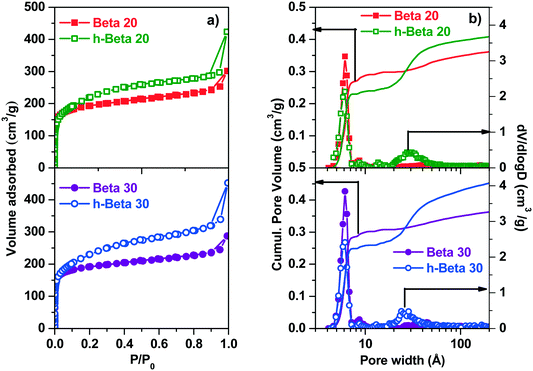 | ||
| Fig. 2 Argon adsorption at −186 °C: (a) isotherms and (b) pore size distributions and cumulative pore volume (NL-DFT). | ||
The zeolite samples were also investigated by solid-state 27Al MAS NMR to get insights about the state and the coordination of the Al species. As illustrated in Fig. 3a, the as-synthesised materials exhibit only the signal at 50 ppm corresponding to tetrahedral coordination of Al atoms, indicating the high efficiency achieved in all cases for the incorporation of the Al species into the zeolite framework. Upon calcination in air at 550 °C, a new peak appears at about 0 ppm, which denotes the formation of extra-framework hexa-coordinated Al species (Fig. 3b). The contribution of this peak is somewhat higher for the hierarchical zeolites, in particular in the case of the sample with the lowest Si/Al ratio, showing that hierarchical Beta materials are more sensitive during calcination to changes in the Al coordination than the conventional Beta samples. Nevertheless, in all cases most of the Al atoms (over 80%) remain as tetrahedrally coordinated species within the zeolite framework after the calcination process.
Another representative parameter to evaluate the aluminium stability and its uniformity in the zeolite structure is the full-width-at-half-maximum (FWHM) of the tetrahedral Al peak in the 27Al MAS NMR spectra.52 The FWHM values for the different samples are recorded in Fig. 3a for the as-made samples. It can be appreciated that the hierarchical Beta zeolites exhibit FWHM values somewhat higher than the conventional samples, which evidences that introducing a secondary porosity contributes to a reduction in the uniformity of the Al environments. This result can be considered a consequence of the mesopore/external surface features. Since the tetrahedral atoms located on this surface present a lower connectivity, a higher flexibility for them is expected in terms of bond lengths and angles.
The acidic properties of the zeolitic materials were investigated by pyridine adsorption followed by FTIR spectroscopy, which enables to distinguish and quantify the concentrations of Brønsted and Lewis acid sites. The spectra obtained before and after adsorption of pyridine over the different Beta zeolites samples are shown in Fig. 4. According to the literature,49,53 the region of OH groups mainly consists of five different bands corresponding to hydroxyl groups stretching vibrations: a) the band at 3783 cm−1 indicates the presence of acidic OH groups bonded to extra-framework aluminum; b) the band at 3745 cm−1 is characteristic of terminal silanols (SiOH); c) the band at 3662 cm−1 is associated to OH groups in extra-framework species (Al–OH); d) the bands between 3605 and 3620 cm−1 are ascribed to acidic bridging Si–OH–Al groups and e) the wide absorption band centred around 3500 cm−1 is related to the presence of species having hydrogen atoms with a weak hydrogen bond, being detected when the zeolite crystallites are rich in defects.
In the region from 4000 to 3300 cm−1, the presence of OH groups related to extra-framework aluminum (3783 and 3662 cm−1)49 is distinguishable in all the spectra before pyridine adsorption (BA). This is in agreement with the above commented 27Al MAS NMR spectra, which denoted the existence of Al species with an octahedral environment (0 ppm). After pyridine sorption at 150 °C, the bands associated to Al–OH and Si–OH–Al groups disappear completely giving rise to new absorption bands located between 1560 and 1400 cm−1. Specifically, the band at 1546 cm−1 is associated to pyridine interacting with Brønsted acid sites (PyH+) whereas those appearing at 1455 and 1464 cm−1 are assigned to Py-Lewis species (PyL). When the temperature increases, Brønsted acid sites reappear giving back the 3607 cm−1 band at 450 °C and evidencing the strength of the remaining active centres. In contrast, the profile of bands associated to pyridine interacting with Lewis acid sites is more complex. When the desorption is carried out at high temperature, a decrease in the intensity of the band at 1455 cm−1 is observed, whereas the opposite occurs with the band at 1464 cm−1.
The latter corresponds to weak Lewis acid sites, although some authors attribute the presence of the 1464 cm−1 band to the combined effect of pyridine molecules migration and “in situ” formation of stronger Lewis acid sites.49
Fig. 5 depicts the concentrations of both types of acid sites for the different zeolite Beta samples and their evolution with the pyridine desorption temperature. Regarding the Brønsted acid sites, conventional zeolites (Beta-20 and Beta-30) show higher concentrations than hierarchical Beta samples, whereas the opposite is observed for Lewis acid sites. Thus, for the hierarchical Beta samples, the concentration of Lewis acid centers is in the range 50–55%, whereas in the conventional Beta zeolites it is slightly below 40%. Accordingly, these results suggest that the acid sites located over the mesopore/external surface present a different acid site distribution from the internal ones with a higher Lewis/Brønsted ratio. For all the materials, the evolution of the acid site concentration with the temperature indicates that the Lewis sites are of a high acid strength, since even at the highest desorption temperature a large portion of pyridine remains adsorbed on Lewis acid centers. As expected, the concentrations of both types of acid sites arise with a decrease in the Si/Al ratio. This effect is more pronounced for the hierarchical Beta sample having the highest Al content (h-Beta-20) due to its high share of mesopore/external surface area.
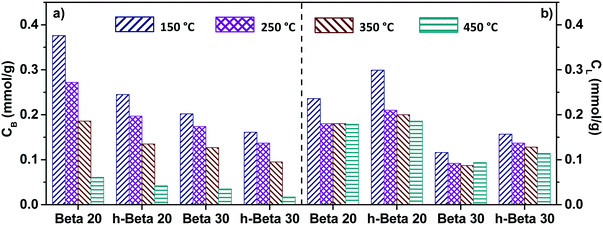 | ||
| Fig. 5 Concentration of acid sites in the zeolite Beta samples after desorption of pyridine at different temperatures measured by FT-IR: (a) Brønsted acid sites (CB) and (b) Lewis acid sites (CL). | ||
3.2. Catalytic performance in liquid-phase Beckmann rearrangement
To probe the impact of the textural and acid properties of hierarchical Beta zeolites on the catalytic activity, the Beckmann rearrangement of oximes was used as the test reaction. Two oximes having different molecular sizes have been selected as model compounds: cyclohexanone and cyclododecanone oximes. The reaction proceeds via the rearrangement of the oximes to the corresponding amides as main products (Scheme 1): ε-caprolactam (monomer for the production of Nylon 6) and ω-laurolactam (monomer for the production of Nylon 12), respectively. However, secondary products are usually detected, mainly the corresponding ketones (cyclohexanone and cyclododecanone, respectively) formed by hydrolysis of the oximes. These rearrangement reactions have been employed in the present work as a catalytic test to evaluate the effect of the mesopores and large external surface areas of hierarchical Beta samples in comparison with the conventional ones, taking into account also their industrial relevance for producing monomers used in the manufacture of commercial polyamides.The mechanism of the Beckmann rearrangement reaction consists of an alkyl migration with expulsion of the hydroxyl group to form a nitrilium ion.54 It involves the initial activation of the oxime at the oxygen atom, which is favored when the cyclic ketoxime possesses a higher number of carbon atoms.55 In this way, due to the high reactivity of cyclododecanone oxime, the reaction tests in the present work were carried out with 100 mg of catalyst in order to obtain conversions below 100%, whereas the catalyst amount in the Beckmann rearrangement of cyclohexanone oxime was set at 150 mg.
Fig. 6 illustrates the conversion obtained along the reaction time in the rearrangement of both oximes over the different zeolite Beta catalysts. In the case of cyclohexanone oxime (Fig. 6a), the conversion increases continuously with the reaction time showing a simple trend for all the zeolite samples. Samples with lower Si/Al ratios show superior conversion, as expected from their higher concentrations of acid sites. Likewise, hierarchical zeolites exhibited an enhanced conversion regarding the reference samples, which confirms the positive effect of the hierarchical porosity by increasing the accessibility towards the acid sites.
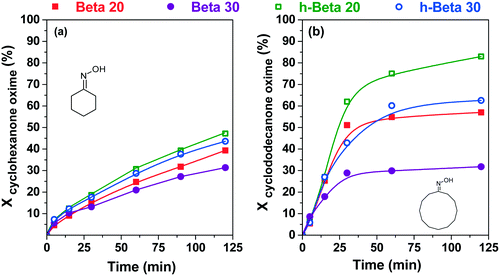 | ||
| Fig. 6 Evolution of the oxime conversion along the reaction time over the zeolite Beta samples: (a) cyclohexanone oxime and (b) cyclododecanone oxime. | ||
When analysing the results obtained with cyclododecanone oxime (Fig. 6b), the above commented general trends can be used to explain the catalytic behaviour of the zeolite samples, although with some remarkable differences from cyclohexanone oxime. Firstly, it must be pointed out that for the larger oxime, the variations observed among the samples in the conversion are more pronounced, indicating that the rearrangement reaction of this substrate is quite sensitive to changes in the textural and acid properties of zeolite Beta. Secondly, in all cases, the conversion curves show two stages as they tend to reach a plateau for reaction times over 30 min, being then just slightly increased along the reaction time. This plateau is not related to the conversion equilibrium since the value of the maximum conversion obtained with each catalyst is very different. This behaviour has been earlier observed in other liquid phase reactions catalysed by zeolites, such as acylation of aromatic substrates, being usually indicative of the presence of inhibition phenomena of the catalytic activity due to the strong adsorption of some of the products over the active sites. Depending on the type, strength and location of the active sites, the effect of the product inhibition on the catalytic activity may be more or less pronounced.56
Fig. 7 represents the average reaction rate, determined in the 30–120 min range, of the cyclohexanone oxime Beckmann rearrangement (estimated from the slope of the oxime conversion curves into lactams) obtained with the different catalysts versus their Al atom concentration (Al/(Al + Si) × 100). In the case of the cyclododecanone oxime, two average reaction rates have been considered corresponding to each one of the two stages observed in the evolution of the conversion along the reaction time: r1 (0–30 min) and r2 (30–120 min). For the cyclohexanone oxime, the major factor determining the catalytic activity seems to be the Al content. However, for the cyclododecanone oxime, the strong influence of the hierarchical porosity is evident for the two reaction stages. Thus, the values of both reaction rates (r1 and r2) are clearly superior for the hierarchical Beta samples, so in this case both parameters (the Al content and the presence of mesopores) control the zeolite catalytic activity. Moreover, the differences between the hierarchical and conventional Beta samples are even more pronounced for the reaction rate calculated in the second stage, with values very superior corresponding to the samples having mesopores. Since in this stage the reaction is strongly affected by the catalyst deactivation, this finding suggests that the presence of secondary pores is also positive for attenuating the zeolite deactivation, probably due to the lower relevance of pore blockage effects at the micropore mouths, although the increased Lewis nature of the acid sites in the mesopore/external surface area must be also taken into account. Thus, it can be concluded that Lewis acid sites are less affected by deactivation through product inhibition.
On the other hand, Fig. 8 illustrates the evolution along the reaction time of the selectivity towards the corresponding lactams. In the case of ε-caprolactam, the reference Beta samples show higher selectivities than the hierarchical zeolites, reaching values about 70% versus 55%, respectively. In contrast, for cyclododecanone oxime, similar selectivity values towards ω-laurolactam are obtained over hierarchical and conventional Beta zeolites, being somewhat higher for the materials with the lowest Si/Al ratio (about 86% versus 77%, respectively).
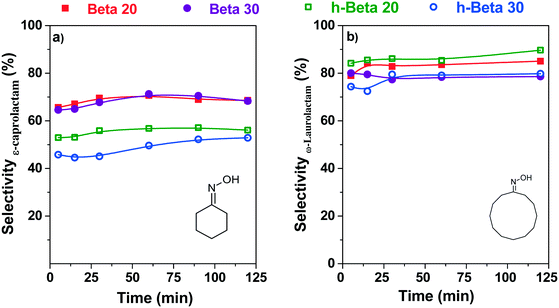 | ||
| Fig. 8 Evolution of the selectivity towards the corresponding lactams along the reaction time over the zeolite Beta samples: (a) ε-caprolactam and (b) ω-laurolactam. | ||
The relationship between the selectivity pattern and the acidic features of these materials is not straightforward since this type of reaction can be catalysed by both Brønsted and Lewis acid sites. In this way, it has been reported that even weak Brønsted sites, associated to silanol nests, may act as active centres for oxime Beckmann rearrangement.57 Likewise, Lewis acid sites have been proposed to catalyse the oxime Beckmann rearrangement reaction via a nucleophilic aromatic substitution, although they are mainly responsible of catalysing the secondary hydrolysis reaction.58 Accordingly, in the case of the hierarchical Beta samples, as they present a higher Lewis to Brønsted acid site ratio, the non-desired hydrolysis reaction of cyclohexanone oxime is favoured, which is in agreement with the lower selectivity towards ε-caprolactam observed over these materials. However, a different selectivity pattern is observed in the conversion of cyclododecanone oxime. For this substrate the selectivities are significantly higher, showing relatively small variations with the Si/Al ratio, the presence of hierarchical porosity and the reaction time evolution. As indicated above, the initial activation of the oxime at the oxygen atom is favored when the cyclic ketoxime presents a higher number of carbon atoms, which leads to an enhanced reactivity in the case of cyclododecanone oxime towards the main rearrangement reaction at the expense of the secondary hydrolysis, so the effects of the different parameters on the latter become less significant.
Overall, these results show that the catalytic behaviour of the hierarchical Beta zeolites in the oxime Beckmann rearrangement can be explained by their improved accessibility, although other factors, such as the Si/Al ratio, the Brønsted/Lewis acid site distribution and the presence of deactivation phenomena must be also taken into account. The effect of these factors is next rationalized:
• Acidity. The influence of the overall acid site concentration on the catalytic activity, which depends mainly on the Si/Al ratio, can be easily explained for both oximes. As expected, a higher concentration of Al sites leads to higher conversions and reaction rates. Regarding the Brønsted/Lewis acid site ratio, it does not have a pronounced effect on the catalytic activity since both types of acid sites are capable of catalysing the main oxime rearrangement reaction. However, the nature of the acid sites has a significant influence on the lactam selectivity because the secondary reaction of oxime hydrolysis is preferentially catalysed by Lewis acid sites. This effect is more clearly seen in the cyclohexanone oxime conversion, being of little relevance for the bulkiest oxime due to its inherent high reactivity towards the rearrangement reaction.
• Diffusional effects. For cyclohexanone oxime, its molecular size (about 6 Å) is small enough to enter the zeolite micropores, so the catalytic activity increase observed over the hierarchical Beta samples should be considered mainly a consequence of faster internal diffusion: enhanced diffusion rate through the mesopores and reduction of the effective length of the intracrystalline diffusional pathway within the zeolite micropores.
• Steric hindrances. The molecular size of cyclododecanone oxime (about 9 Å) is quite larger than the micropore diameter of the zeolitic BEA structure, which implies that the reaction proceeds just over the mesopore/external surface or at the micropore mouths. Accordingly, the oxime conversion and the reaction rate corresponding to the first stage (at short reaction times) are clearly higher for the hierarchical Beta zeolites as they show larger mesopore/external surface area. However, the increase of the reaction rate is lower than the one expected according to the amount of mesopore/external surface area of the samples, which is probably due to the lower intrinsic catalytic activity of the Lewis acid sites located over that surface in the hierarchical samples.
• Catalyst deactivation by product inhibition. This effect has been clearly observed in the case of the cyclododecanone oxime through the presence of a plateau at long reaction times. Both the overall oxime conversion and the reaction rate corresponding to the second stage are quite higher for the hierarchical zeolites than the conventional ones, showing that they are less affected by product inhibition. As the reaction may take place in this case on the mesopore/external zeolite surface and at the micropore mouths, two reasons can be provided to explain this behaviour: the Lewis acid sites in the mesopore/external surface are less prone to deactivation by product inhibition, whereas the active sites located in the micropore mouths are affected less by pore blockage effects.
4. Conclusions
Hierarchical Beta zeolites with different Si/Al ratios, prepared through silanization of protozeolitic units, show an additional porosity in the mesopore range which provides them with a high mesopore/external surface area (about 300 m2 g−1) and, therefore, with enhanced accessibility. The hierarchical Beta samples also present some relevant differences in the acidic properties from conventional Beta zeolites, with a higher contribution of Lewis acidity.Hierarchical and conventional Beta zeolites were probed on the liquid-phase Beckmann rearrangement of two oximes with different molecular sizes (cyclohexanone and cyclododecanone oximes). The results of catalytic activity so obtained confirmed the relevance of the accessibility towards the active sites. The largest differences among the samples were observed for the cyclododecanone oxime rearrangement, indicating that this reaction is very sensitive to changes in the textural and acid properties of zeolite Beta. Moreover, for the bulkiest substrate, the conversion curves reach a plateau along the reaction time, denoting the occurrence of product inhibition phenomena.
The presence of a secondary porosity in the hierarchical Beta zeolites influences positively their catalytic activity, enhancing the overall reaction rate and attenuating the catalyst deactivation, although for the smallest oxime it also reduces the lactam selectivity as it favors the secondary hydrolysis reaction. These significant changes in the catalytic behavior compared to the conventional Beta samples can be assigned to a number of factors derived from the presence of the hierarchical porosity: large mesopore/external surface area, increased Lewis acid site concentration, faster intraparticle diffusion, lower steric hindrances and better resistance to deactivation by product inhibition.
Acknowledgements
The financial support of the Spanish government (CTQ 2011/22707 and CTQ2014-57858-R) is gratefully acknowledged. The work of J. Č. was supported by the Czech Science Foundation Grant No. P106/12/G015 (Centre of Excellence).References
- A. Corma and H. García, Catal. Today, 1997, 38, 257 CrossRef CAS.
- F. Vaundry, F. Di Renzo, F. Fajula and F. Schulz, J. Chem. Soc., Faraday Trans., 1998, 94, 617 RSC.
- R. Dimitrova, G. Gunduzb, L. Dimitrov, T. Tsoncheva, S. Yialmaz and E. A. Urquieta-Gonzalez, J. Mol. Catal. A: Chem., 2004, 214, 265 CrossRef CAS.
- K. Hensen, C. Mahaim and W. F. Hölderich, Appl. Catal., A, 1997, 149, 311 CrossRef CAS.
- R. Kore, R. Srivastava and B. Satpati, Appl. Catal., A, 2015, 493, 129 CrossRef CAS.
- F. J. Maldonado, T. Bécue, J. M. Silva, M. F. Ribeiro, P. Massiani and M. Kermareczv, J. Catal., 2000, 195, 342 CrossRef CAS.
- J. Pérez-Ramírez, C. H. Christensen, K. Egeblad, C. H. Christensen and J. C. Groen, Chem. Soc. Rev., 2008, 37, 2530 RSC.
- C. E. A. Kirschhock, S. P. B. Kremer, J. Vermant, G. Van Tendeloo, P. A. Jacobs and J. A. Martens, Chem. – Eur. J., 2005, 11, 4306 CrossRef CAS PubMed.
- J. Čejka and S. Mintova, Catal. Rev.: Sci. Eng., 2007, 49, 457 Search PubMed.
- K. Na, C. Jo, J. Kim, K. Cho, J. Jung, Y. Seo, R. J. Messinger, B. F. Chmelka and R. Ryoo, Science, 2011, 333, 328 CrossRef CAS PubMed.
- D. Trong On and S. Kaliaguine, Angew. Chem., Int. Ed., 2001, 40, 3248 CrossRef.
- D. P. Serrano, J. M. Escola and P. Pizarro, Chem. Soc. Rev., 2013, 42, 4004 RSC.
- J. Pérez-Ramírez, S. Abelló, A. Bonilla and J. C. Groen, Adv. Funct. Mater., 2009, 19, 164 CrossRef.
- Y. H. Chou, C. S. Cundy, A. A. Garforth and V. L. Zholobenko, Microporous Mesoporous Mater., 2006, 89, 78 CrossRef CAS.
- K. Egleblad, C. H. Christensen, M. Kustova and C. H. Christensen, Chem. Mater., 2008, 20, 946 CrossRef.
- D. P. Serrano, J. Aguado, J. M. Escola, J. M. Rodríguez and A. Peral, Chem. Mater., 2006, 18, 2462 CrossRef CAS.
- J. Aguado, D. P. Serrano and J. M. Rodríguez, Microporous Mesoporous Mater., 2008, 115, 504 CrossRef CAS.
- D. P. Serrano, R. Sanz, P. Pizarro and I. Moreno, Top. Catal., 2010, 53, 1319 CrossRef CAS.
- D. P. Serrano, R. Sanz, P. Pizarro and I. Moreno, Chem. Eng. J., 2011, 171, 1428 CrossRef.
- J. Aguado, D. P. Serrano, J. M. Escola and A. Peral, J. Anal. Appl. Pyrolysis, 2009, 85, 352 CrossRef CAS.
- D. P. Serrano, R. Sanz, P. Pizarro, I. Moreno and S. Medina, Appl. Catal., B, 2014, 146, 35 CrossRef CAS.
- M. D. González, P. Salagre, M. Linares, R. A. García and D. P. Serrano, Appl. Catal., A, 2014, 473, 75 CrossRef.
- D. P. Serrano, R. A. García, G. Vicente, M. Linares, D. Procházková and J. Čejka, J. Catal., 2011, 279, 366 CrossRef CAS.
- R. A. García-Muñoz, D. P. Serrano, G. Vicente, M. Linares, D. Vitvarová and J. Čejka, Catal. Today, 2015, 243, 141 CrossRef.
- M. B. Smith and J. March, Advanced Organic Chemistry, John Wiley & Sons, New York, 2001, p. 1415 Search PubMed.
- W. B. Fisher and L. Crescentini, Caprolactam Kirk-Othmer Encyclopedia of Chemical Technology, John Wiley & Sons, New York, 2015 Search PubMed.
- S. Sato, K. Urabe and Y. Izumi, J. Catal., 1986, 102, 99 CrossRef CAS.
- T. Curtin, J. B. McMonagle and B. K. Hondnett, Appl. Catal., A, 1992, 93, 75 CrossRef CAS.
- C. Ngamcharussrivichai, P. Wu and T. Tatsumi, J. Catal., 2005, 235, 139 CrossRef CAS.
- A. Behr, Catalysis Homogeneous, Ullmanns Encyclopedia of Industrial Chemistry, John Wiley & Sons, New York, 2010 Search PubMed.
- W. F. Hölderich, J. Röseler, G. Heitmann and A. T. Liebens, Catal. Today, 1997, 37, 353 CrossRef.
- C. Yin, R. Ni, X. Bao and Y. Chen, Microporous Mesoporous Mater., 2015, 202, 133 CrossRef CAS.
- P. Botella, A. Corma, S. Iborra, R. Montón, I. Rodríguez and V. Costa, J. Catal., 2007, 250, 161 CrossRef CAS.
- A. B. Fernández, A. Marinas, T. Blasco, V. Fornés and A. Corma, J. Catal., 2006, 243, 270 CrossRef.
- J. Kim, W. Park and R. Ryoo, ACS Catal., 2011, 1, 337 CrossRef CAS.
- T. D. Conesa, R. Mokaya, Z. Yang, R. Luque, J. M. Campelo and A. A. Romero, J. Catal., 2007, 252, 1 CrossRef CAS.
- E. G. Vaschetto, S. G. Casuscelli and G. A. Eimer, Microporous Mesoporous Mater., 2016, 221, 175 CrossRef CAS.
- J.-C. Chang and A.-N. Ko, Catal. Today, 2004, 97, 241 CrossRef CAS.
- T. D. Conesa, J. M. Hidalgo, R. Luque, J. M. Campelo and A. A. Romero, Appl. Catal., A, 2005, 299, 224 CrossRef.
- R. Maheswari, K. Shanthi, T. Sivakumar and S. Narayanan, Appl. Catal., A, 2003, 248, 291 CrossRef CAS.
- R. Kumar, S. Shah, J. Bahadur, Y. B. Melnichenko, D. Sen, S. Mazumder, C. P. Vinod and B. Chowdhary, Microporous Mesoporous Mater., 2016, 234, 293 CrossRef CAS.
- N. C. Marziano, L. Ronchin, C. Tortato, A. Vavasori and C. Badetti, J. Mol. Catal. A: Chem., 2007, 277, 221 CrossRef CAS.
- S. Guo and Y. Deng, Catal. Commun., 2005, 6, 225 CrossRef CAS.
- M. A. Camblor, A. Corma, H. García, V. Semmer-Herlédan and S. Valencia, J. Catal., 1998, 177, 267 CrossRef CAS.
- M. Opanasenko, M. Shamzhy, M. Lamač and J. Čejka, Catal. Today, 2013, 204, 94 CrossRef CAS.
- M. Opanasenko, Catal. Today, 2015, 243, 2 CrossRef CAS.
- J. Aguado, D. P. Serrano and J. M. Rodríguez, Microporous Mesoporous Mater., 2008, 115, 504 CrossRef CAS.
- C. A. Emeis, J. Catal., 1993, 141, 347 CrossRef CAS.
- B. Gil, S. I. Zones, S.-J. Hwang, M. Bejblová and J. Čejka, J. Phys. Chem. C, 2008, 112, 2997 CAS.
- D. F. Taber and P. J. Straney, J. Chem. Educ., 2010, 87, 1392 CrossRef CAS.
- J. Aguado, D. P. Serrano, J. M. Escola and J. M. Rodríguez, Microporous Mesoporous Mater., 2004, 75, 41 CrossRef CAS.
- E. Oldfield, J. Haase, K. D. Schmitt and S. E. Schramm, Zeolites, 1994, 14, 101 CrossRef CAS.
- B. Gil, L. Mokrzycki, B. Sulikowski, Z. Olejniczak and S. Walas, Catal. Today, 2010, 152, 24 CrossRef CAS.
- P. S. Landis and P. B. Venuto, J. Catal., 1966, 6, 245 CrossRef CAS.
- M. Hashimoto, Y. Obora, S. Sakaguchi and Y. Ishii, J. Org. Chem., 2008, 73, 2894 CrossRef CAS PubMed.
- E. G. Vaschetto, G. A. Monti, E. R. Herrero, S. G. Casuscelli and G. A. Eimer, Appl. Catal., A, 2013, 453, 391 CrossRef CAS.
- E. G. Vaschetto, G. A. Pecchi, S. G. Casuscelli and G. A. Eimer, Microporous Mesoporous Mater., 2014, 200, 110 CrossRef CAS.
- C. Ngamcharussrivichai, P. Wu and T. Tatsumi, Appl. Catal., A, 2005, 288, 158 CrossRef CAS.
| This journal is © The Royal Society of Chemistry 2017 |

